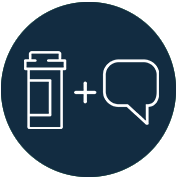Clinical Interventions to Treat Tobacco Use and Dependence Among Adults
Tobacco use and dependence is a chronic, relapsing condition that often requires repeated intervention and long-term support. Quitting can be hard, but evidence-based treatments improve success. Below are clinical interventions that work to help adult patients quit smoking.
Clinical Interventions Work
Tobacco use and dependence is a chronic, relapsing condition that often requires repeated intervention and long-term support. Quitting can be hard, but evidence-based treatments (listed below) improve success.
- Behavioral Counseling:
- Counseling can be in person (one-on-one or in a group) or over a telephone quitline.
- Text messaging and web-based interventions also help people quit smoking.
- Medication: Seven medications are approved by the U.S. Food and Drug Administration (FDA) for smoking cessation.
- Nicotine Replacement Therapy (NRT) reduces nicotine withdrawal symptoms and is available over the counter (patch, gum, and lozenge) and by prescription (inhaler and nasal spray).
- Varenicline is a nicotine receptor partial agonist available only by prescription. It reduces nicotine withdrawal symptoms (including craving) and reduces the rewarding effects of cigarettes by blocking nicotinic receptors.
- Bupropion is a dopamine and norepinephrine reuptake inhibitor with nicotine receptor antagonist properties. It reduces craving and other withdrawal symptoms and is available by prescription only.
- Combining Treatments:
- Counseling and medication are effective on their own but using them together can more than double the chances of quitting.
- Combining long-acting NRT (patch) with short-acting NRT (e.g., gum, lozenge) also increases the chances of quitting.
For Non-Pregnant Patients
Behavioral Counseling:
- Counseling can be in person (one-on-one or in a group) or over a telephone quitline.
- Text messaging (e.g., SmokefreeTXT) and web-based interventions (e.g., cdc.gov/quit and smokfree.gov) also help people quit smoking.
Medication: Seven medications are approved by the U.S. Food and Drug Administration (FDA) for smoking cessation.
- Nicotine Replacement Therapy (NRT) reduces nicotine withdrawal symptoms and is available over the counter (patch, gum, and lozenge) and by prescription (inhaler and nasal spray).
- Varenicline is a nicotine receptor partial agonist available only by prescription. It reduces nicotine withdrawal symptoms (including craving) and reduces the rewarding effects of cigarettes by blocking nicotinic receptors.
- Bupropion is a dopamine and norepinephrine reuptake inhibitor with nicotine receptor antagonist properties. It reduces craving and other withdrawal symptoms and is available by prescription only.
Combining Treatments:
- Counseling and medication are effective on their own but using them together can more than double the chances of quitting.
- Combining long-acting NRT (patch) with short-acting NRT (e.g., gum, lozenge) also increases the chances of quitting.
E-Cigarettes and Pregnancy
- E-cigarettes are not safe to use during pregnancy.
- Nicotine is a health danger for pregnant women and developing babies and can damage a developing baby’s brain and lungs.
- There is currently not enough evidence to know whether e-cigarettes increase smoking cessation.
- E-cigarettes are not currently approved by the U.S. Food and Drug Administration (FDA) as a smoking cessation aid.
Resources for Patient Care Settings and Smoking Cessation
Page last reviewed: June 8, 2021









